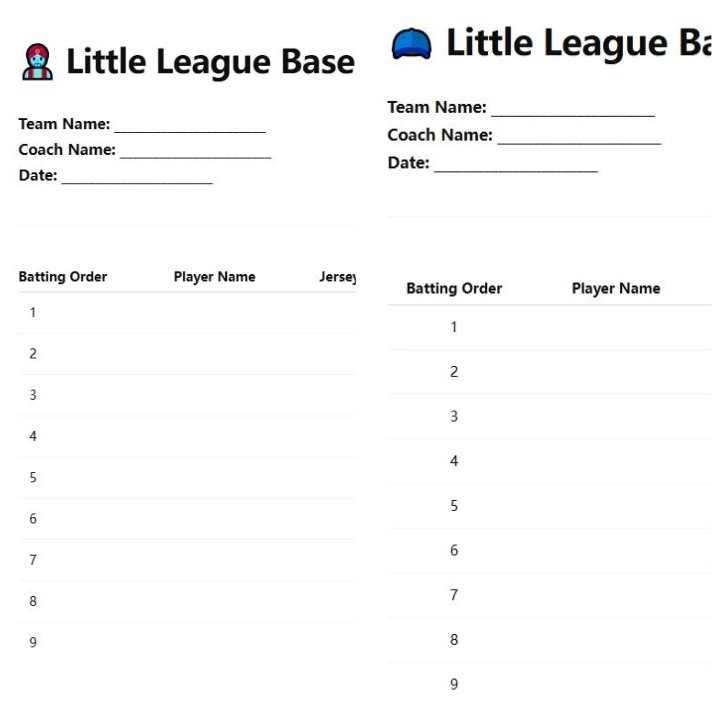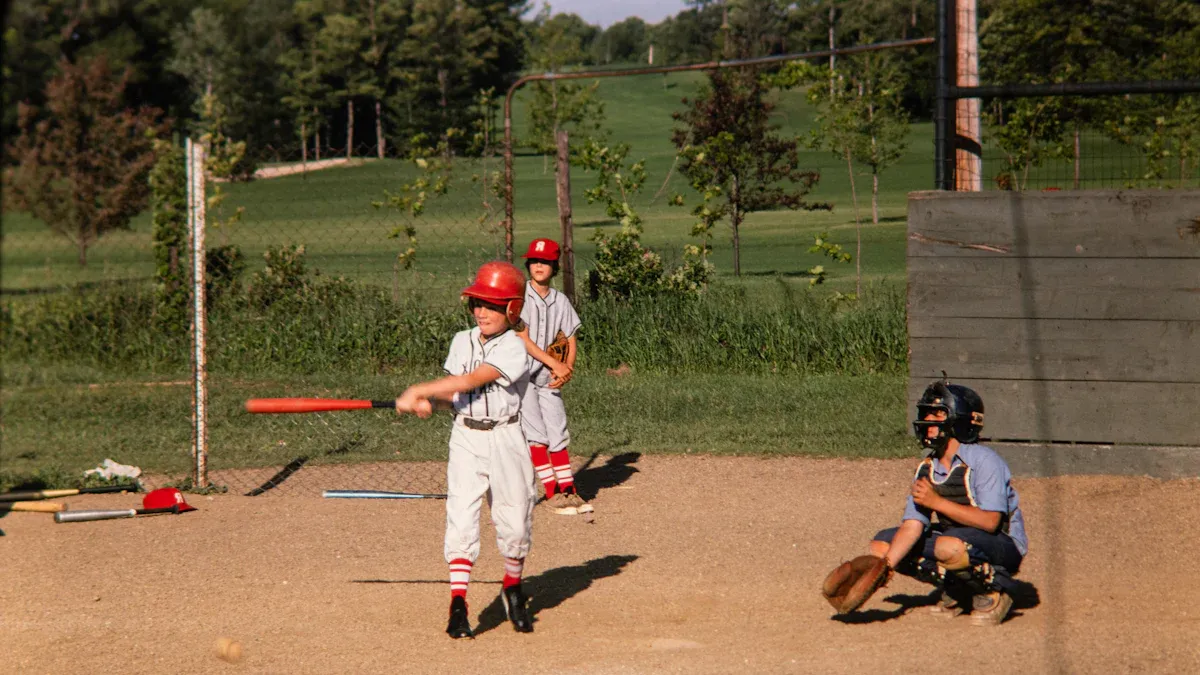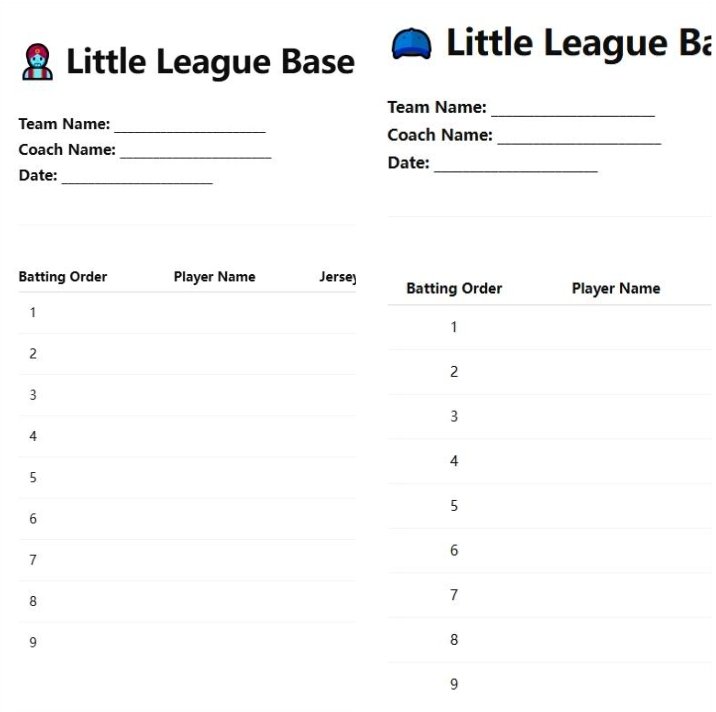
Getting your baseball lineup right is very important. It helps whether you’re coaching kids, teens, or adults. A good lineup shows each player’s role and batting order. Instead of using messy papers or spreadsheets, use ChatGPT. This tool makes creating a lineup simple and fast. Whether it’s for a big game or a fun match, ChatGPT helps you plan everything your team needs.
Key Takeaways
Use ChatGPT to make a baseball lineup template fast. Just type what you need, and it creates one in minutes.
Change your lineup to match your team or league. Edit templates for Little League, school teams, or fantasy baseball as needed.
Plan your lineup by knowing your league and key details. Add player stats, positions, and notes to improve your strategy.
Pick the best format for your template. Choose from printable files, Excel sheets, or online pages based on your needs.
Save and update your templates often. Keep them neat and ready all season to stay prepared for every game.
Why Use GPT for a Baseball Lineup Template?
Making a baseball lineup can feel hard and boring. ChatGPT helps by making it simple and quick. Let’s see why this AI tool is so helpful for lineups.
Saves time and is easy to use: no fancy tools needed
You don’t need to spend hours using tricky software. ChatGPT makes a lineup template in just minutes. Just tell it what you need, and it does the work.
For example, if you need a printable lineup for Little League, ask ChatGPT. It can add spaces for player names, positions, and batting order. All you do is type your request. This saves time so you can focus on coaching or planning for the next game.
Tip: Managing a fantasy baseball team? Use ChatGPT to make a lineup. It can track player stats and matchups. Stay ahead of others easily.
Customizable: Make it fit any team or league style
Every team is different, and your lineup should show that. ChatGPT lets you change templates to fit your needs. Whether it’s for high school, a fun league, or fantasy baseball, you can make it your own.
Want to add spots for substitutes or notes? Just ask. Need it to look like a Major League lineup? ChatGPT can do that too. It’s like having a helper who knows baseball and listens to you.
With ChatGPT, you’re not stuck with boring templates. You get a lineup that fits your team, league, and goals.
What to Think About Before Making Your Template
Before starting your baseball lineup template, take time to plan. Knowing your team’s needs and format will save effort later.
Know What You Need
Type of league
Think about the league you’re working with. Is it Little League, high school, or adult recreational? Each has different needs. For example, Little League might need spots for substitutes. High school teams may focus on positions and batting orders. Knowing your league helps you make the right template.
Important details for the lineup
Decide what info to include. Do you need just names and positions? Or do you want stats like batting averages or performance against pitchers? These details can improve your lineup. For example, knowing how a player hits against certain pitchers helps you plan better. Don’t forget injuries—they affect performance. Adding a notes section for these can be very helpful.
Pick the Format
Printable Word doc, fillable PDF, Excel, or webpage
Choose how you’ll use your template. Do you want something printable, like a Word doc or PDF? Or would Excel or an interactive webpage work better? Each has benefits.
Why each format works
Printable Word doc or PDF: Good for coaches who need paper copies during games. Easy to share and fill out by hand.
Excel: Great for tracking stats and quick updates. Formulas can calculate averages or totals.
Interactive webpage: Best for tech-savvy users or fantasy baseball fans. Update it live and share it online.
Pick the format that fits your needs. If you’re on the field, printed versions are handy. For tracking stats, Excel or a webpage is smarter.
Step-by-Step Guide on How to Use GPT for Your Baseball Lineup Template

Decide What You Need
List the main parts of your lineup template
Before making your baseball lineup template, think about what it needs. A good template helps you organize your team’s info better. Here’s a simple list of features you might want:
Feature | What It Does |
|---|---|
Player roster | Lists player names, positions, and numbers. |
Batting order sequence | Shows the order players will bat. |
Defensive positioning charts | Maps where players stand on the field. |
Player statistics tracking | Keeps track of how players perform. |
Substitution planning fields | Helps plan when to switch players. |
Game-by-game performance metrics | Tracks how players do in each game. |
Season-long statistical summaries | Summarizes player and team stats for the season. |
Pitch count tracking | Counts how many pitches pitchers throw. |
Player availability status | Shows which players can play. |
Statistical calculations | Calculates important stats like batting averages. |
These features make managing your team easier, whether it’s Little League or fantasy baseball.
Add common fields
When creating your template, include basic fields everyone needs. For example, player names, positions, and batting order are essential. If it’s for fantasy baseball, add fields for scouting reports and player stats. These details help you build a stronger team.
Write Your GPT Prompt
Use clear examples of prompts
To get the best results from ChatGPT, write clear prompts. Here are some examples to try:
Basic Template:
“Make a baseball lineup template for Little League. Include player names, positions, batting order, and substitutes.”Fantasy Baseball:
“Create a fantasy baseball lineup template. Add fields for player stats, scouting reports, and draft strategy notes.”Advanced Template:
“Design a high school baseball lineup template. Include a defensive chart, player stats, and game-by-game performance tracking.”
These prompts help ChatGPT create a template that fits your needs quickly.
Use this Example Promt to Easy Create Your Lineup Template
“Hi GPT! Please create a baseball lineup template suitable for a Little League team. The template should include the following sections:
Team Information:
Space for Team Name
Space for Coach Name
Space for Date
Batting Order (with columns for):
Batting Order (1-9)
Player Name
Jersey Number
Field Position (such as 1B, 2B, SS, OF, etc.)
Notes (for optional notes, e.g., special instructions, player status)
Bench Players:
Space to list Bench Players and their Jersey Numbers
Option for Notes for each player
Pitchers:
A section to list Starting Pitcher and Relief Pitchers
Visuals:
Include a baseball icon at the top to make it visually appealing
Please format this in a clean, easy-to-read layout for printing. The template should be printable (e.g., Word doc) and organized for quick use during the game or practice.”
Optional Additions:
If possible, allow for flexibility where coaches can modify positions or add additional notes.
Personalize Your Baseball Lineup Template
Add a baseball icon
A small detail like a baseball icon can make your template look cool. Ask ChatGPT to add one at the top or near player names. It’s a fun way to make your lineup unique.
Include Player Info and Positions
Make sure your template has space for player names, numbers, and positions. For fantasy baseball, add fields for scouting reports and player evaluations. These details help you judge each player’s skills.
Adjust for League Rules or Fantasy Settings
Every league has different rules. For example, Major League Baseball focuses on stats like slugging percentages. Little League might care more about substitutions. Use ChatGPT to tweak your template for your league. For fantasy baseball, add fields for draft plans and player availability.
Add Sections for Substitutes and Notes
Don’t forget to include spots for substitutes and notes. These are helpful for tracking who can play and planning strategies. Whether it’s a serious league or a casual one, these features make your lineup more flexible.
Get the Final Version
Finish your template in the format you prefer
After customizing your baseball lineup, finalize it for use. Think about how you’ll need it during games or for fantasy baseball. Do you want a printed version for quick access on the field? Or maybe an Excel sheet to track stats and draft plans? ChatGPT can help you pick the best format.
For example, if you manage a fantasy baseball team, an Excel file or interactive webpage might work best. These formats let you update player info and adjust strategies instantly. If you coach a Little League team, a simple PDF or Word document is great for printing and sharing.
When finalizing, make sure your lineup is strategic. Place top hitters in spots where they can score the most runs. For instance, the fourth batting spot is often key for driving in runs. This setup can boost your team’s performance and give you an edge.
Save your template for later use
Once done, save your template in a safe place. Create a folder on your computer or cloud storage called “Baseball Lineups” or “Fantasy Baseball Templates.” This makes it easy to find and reuse throughout the season. If using Excel or a webpage, save different versions for tournaments or specific games.
Pro Tip: Back up your templates often. Losing your lineup mid-season can be a big hassle, especially if you’ve worked hard on it.
Save, Print, and Use!
Save and print your template
Saving your template is just the start. If it’s printable, make a few copies before each game. Keep one in your coaching bag and another in the dugout for quick use. For fantasy baseball, save it as a PDF or Excel file to share with your league.
Printing your lineup ensures you always have a backup, even if your device dies. Plus, it’s handy for writing quick notes during games, like player stats or substitution ideas.
Tips for using the template all season
Reusing your template saves time and keeps things organized. Update it weekly or after games to reflect changes in player stats, injuries, or availability. For fantasy baseball, adjust your draft plans and scouting reports as new data comes in.
If you manage multiple teams, make separate templates for each. Label them clearly, like “Little League Spring 2024” or “Fantasy Baseball 2024.” This keeps you organized and ready for every game.
Quick Tip: Use ChatGPT to update your template during the season. Whether adding new fields or adjusting for rules, AI makes it simple to keep your lineup effective.
Examples of Baseball Lineup Templates

Simple Lineup Template for Beginners
Starting with baseball? Use a basic lineup template. It includes player names, positions, and batting order. This is great for Little League or casual games.
Make a table with three columns. One column is for the player’s name. Another is for their position. The last column is for batting order. This keeps your team organized and easy to manage.
Tip: Try AI tools like ChatGPT to make a neat template. Add a fun baseball icon to make it exciting for younger players.
Advanced Template with Fielding Positions
Competitive leagues need detailed templates. Include fielding positions, defensive stats, and substitution plans. These help track your team’s defense performance.
Here’s how fielding stats improve your lineup:
Metric | Description | Elite Range | League Leaders |
|---|---|---|---|
DRS | 15+ DRS | Daulton Varsho – 29 DRS, Fernando Tatis Jr – 27 DRS | |
UZR | Ultimate Zone Rating measures fielding by zones. | 12+ UZR | Brenton Doyle – 24.0 UZR, Fernando Tatis Jr – 17.2 UZR |
Adding these stats helps find players who save runs or cover ground. Using this data gives your team a smart advantage.
Pro Tip: For Major League or competitive teams, use AI to track these stats automatically.
Fantasy Baseball Lineup Template
Fantasy baseball needs a different setup. Focus on player stats, scouting reports, and draft plans. A good template helps you pick better players and plan drafts.
Include fields for batting averages, home runs, and player availability. Add a notes section for scouting reports. This helps track strengths and weaknesses. Use this info to adjust your lineup during the season.
Quick Tip: Use AI to make a fantasy template that updates stats live. This keeps your data accurate for smarter decisions.
Extra Ideas to Improve Your Lineup Template
Add pitching rotation, defense roles, and game tracking
Including pitching rotations, defense roles, and game tracking makes team management easier. These features help you stay ready and make smart choices during games. For example, tracking player positions lets you change lineups fast for lefty or righty pitchers. It also helps you handle sudden roster changes, like injuries.
Here’s how these features can help your lineup:
Feature | What It Does |
|---|---|
Adjust lineups quickly for lefty/righty pitcher matchups in different situations. | |
Handle Roster Changes | Keep backup player info and update availability during injuries. |
Study Defensive Skills | Record fielding stats and experience to check team defense strengths. |
Using these tools lets you study your team’s abilities and make smart, data-based decisions to improve performance.
Use GPT for game-day sheets with matchup details
Game-day sheets with matchup info give your team an advantage. AI tools like GPT can create detailed sheets with predictions, scouting reports, and stats. For example, if facing a strong opponent, GPT can show expected results and key player performances.
Here’s an example of a game-day sheet:
Matchup | Expected Results | Key Player Performances | Stats Insights |
|---|---|---|---|
Team A vs Team B | Team A likely wins | Player X performs well | Team A wins 70% of games vs Team B |
You can also add injury risks and tips for better matchups. These sheets help you plan strategies and get the most from your team.
Save templates for tournaments, seasons, or player groups
Organizing templates by tournament, season, or player group keeps you ready. For example, make separate templates for Little League, high school, or pro baseball. Label them clearly, like “Spring 2024 Draft” or “Summer Tournament Lineup,” for easy access.
Saving templates for different uses is helpful long-term. You can reuse them, adjust them for new rules, or adapt them for other teams. This saves time and keeps things consistent all season. Plus, AI tools let you update templates fast with new data or reports.
Pro Tip: Store templates in the cloud to avoid losing them. This way, you can access your lineup anytime, anywhere.
Using ChatGPT to make a baseball lineup is super helpful. It’s fast, simple, and fits what you need. Whether coaching a team or playing fantasy baseball, ChatGPT keeps you prepared and organized. Try different prompts and options to use this AI tool fully. Include player info, match league rules, and tweak lineups for each game. With ChatGPT, your lineup will always be ready and perfect.
FAQ
How can I use ChatGPT to make a baseball lineup?
Type what you need into ChatGPT. For example, say, “Make a Little League baseball lineup template.” Include details like player positions or batting order. ChatGPT will create your template quickly.
Can ChatGPT make templates for different types of leagues?
Yes! ChatGPT works for Little League, high school, or fantasy baseball. Tell it your league type and any special needs, like substitutes or stats.
What format should I pick for my lineup template?
Choose based on your needs. PDFs are good for printing during games. Excel helps track stats easily. Webpages are great for fantasy baseball updates.
Can I change my template during the season?
Of course! ChatGPT lets you update your template anytime. Add fields for injuries, stats, or substitutions. It’s fast and keeps your lineup accurate.
Is ChatGPT free to use for this?
ChatGPT has free and paid options. The free version works for basic templates. For advanced features or faster replies, try ChatGPT Plus.
